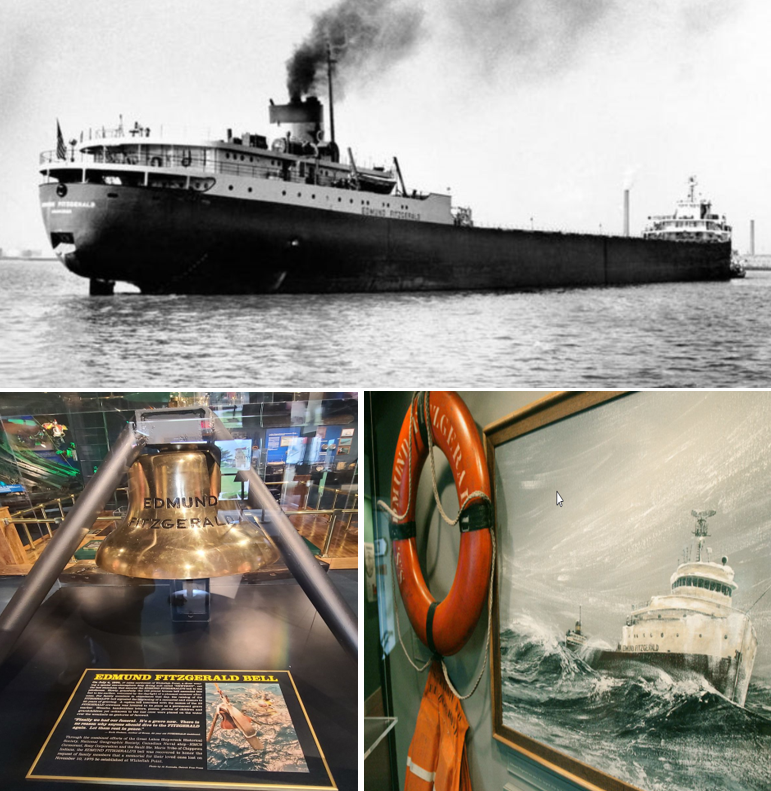If you are a Boomer or an early Gen X, do you remember November 10 -11, 1975?
Owosso Mi. – It was on this date in 1975 when one of the largest boats to sail on the Great Lakes, The Edmund Fitzgerald, along with its 29 crew members fought a great battle against Mother Nature and then lost and sank in Lake Superior on November 11.
The Edmund Fitzgerald at 729 feet long, built in 1958, was the largest boat that sailed the Great Lakes up to 1971.
An interesting point that we will bring up here is that mariners refer to ships as those watercrafts that sail the oceans and Boats, no matter what size that sail the inland seas.
An intense autumn storm moved over the Great Lakes region on November 10, 1975. It was exceedingly treacherous producing high wind and tall waves on Lake Superior. The Edmund Fitzgerald carrying a full load of iron ore pellets.
Sean Ley, Development Officer, tells the tale the best in what he called The Fateful Journey:
The final voyage of the Edmund Fitzgerald began November 9, 1975 at the Burlington Northern Railroad Dock No.1, Superior, Wisconsin. Captain Ernest M. McSorley had loaded her with 26,116 long tons of taconite pellets, made of processed iron ore, heated and rolled into marble-size balls. Departing Superior about 2:30 pm, she was soon joined by the Arthur M. Anderson, which had departed Two Harbors, Minnesota under Captain Bernie Cooper. The two ships were in radio contact. The Fitzgerald being the faster took the lead, with the distance between the vessels ranging from 10 to 15 miles.
Aware of a building November storm entering the Great Lakes from the great plains, Captain McSorley and Captain Cooper agreed to take the northerly course across Lake Superior, where they would be protected by highlands on the Canadian shore. This took them between Isle Royale and the Keweenaw Peninsula. They would later make a turn to the southeast to eventually reach the shelter of Whitefish Point.
Weather conditions continued to deteriorate. Gale warnings had been issued at 7 pm on November 9, upgraded to storm warnings early in the morning of November 10. While conditions were bad, with winds gusting to 50 knots and seas 12 to 16 feet, both Captains had often piloted their vessels in similar conditions. In the early afternoon of November 10, the Fitzgerald had passed Michipicoten Island and was approaching Caribou Island. The Anderson was just approaching Michipicoten, about three miles off the West End Light.
Captain Cooper maintained that he watched the Edmund Fitzgerald pass far too close to Six Fathom Shoal to the north of Caribou Island. He could clearly see the ship and the beacon on Caribou on his radar set and could measure the distance between them. He and his officers watched the Fitzgerald pass right over the dangerous area of shallow water. By this time, snow and rising spray had obscured the Fitzgerald from sight, visible 17 miles ahead on radar.
At 3:30 pm that afternoon, Captain McSorley radioed Captain Cooper and said: “Anderson, this is the Fitzgerald. I have a fence rail down, two vents lost or damaged, and a list. I’m checking down. Will you stay by me till I get to Whitefish?” McSorley was checking down his speed to allow the Anderson to close the distance for safety. Captain Cooper asked McSorley if he had his pumps going, and McSorley said, “Yes, both of them.”
“The Wreck Site II” by David Conklin: Available online in the Shipwreck Coast Museum Store.
As the afternoon wore on, radio communications with the Fitzgerald concerned navigational information but no extraordinarily alarming reports were offered by Captain McSorley. At about 5:20 pm the crest of a wave smashed the Anderson’s starboard lifeboat, making it unusable. Captain Cooper reported winds from the NW x W (305 ) at a steady 58 knots with gusts to 70 knots, and seas of 18 to 25 feet.
According to Captain Cooper, about 6:55 pm, he and the men in the Anderson’s pilothouse felt a “bump”, felt the ship lurch, and then turned to see a monstrous wave engulfing their entire vessel from astern. The wave worked its way along the deck, crashing on the back of the pilothouse, driving the bow of the Anderson down into the sea.
“Then the Anderson just raised up and shook herself off of all that water – barrooff – just like a big dog. Another wave just like the first one or bigger hit us again. I watched those two waves head down the lake towards the Fitzgerald, and I think those were the two that sent him under.”
The Coast Guard believes that the Edmund Fitzgerald went down at 7:15 EST on Nov. 11, 1975
No bodies were ever recovered from the wreckage. Later when the wreck was found, it was discovered that the ship had broken in two. It still sits on the bottom of Lake Superior at 530 feet deep.
In 1977, the U.S Coast Guard pinned the sinking on massive flooding of the cargo hold caused by faulty or poorly fastened hatch covers. The slow flooding supposedly went unnoticed by the captain and crew until it caused an imperceptible but fatal buoyancy loss and eventually sent the Fitzgerald plunging to the bottom.
More than 10,000 lives have been lost and there are roughly 6,000 shipwrecks on record in the five inland seas over the last 400 years. Approximately 240 ships have sunk in the Whitefish Point area, where the Edmund Fitzgerald went down, since statistics were first kept in 1816,
Click on the links to learn more and to enjoy the song by Gordon Lightfoot.
https://www.glerl.noaa.gov/pubs/fulltext/2006/20060016.pdf
https://www.shipwreckmuseum.com/edmund-fitzgerald/the-fateful-journey/
https://en.wikipedia.org/wiki/SS_Edmund_Fitzgerald
https://www.mlive.com/news/2017/11/8_facts_behind_the_edmund_fitz.html











Comments